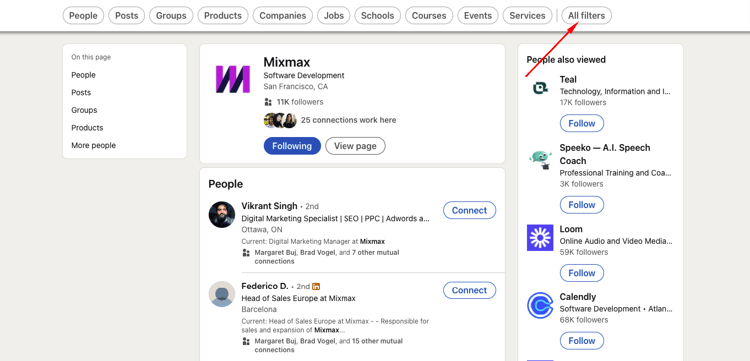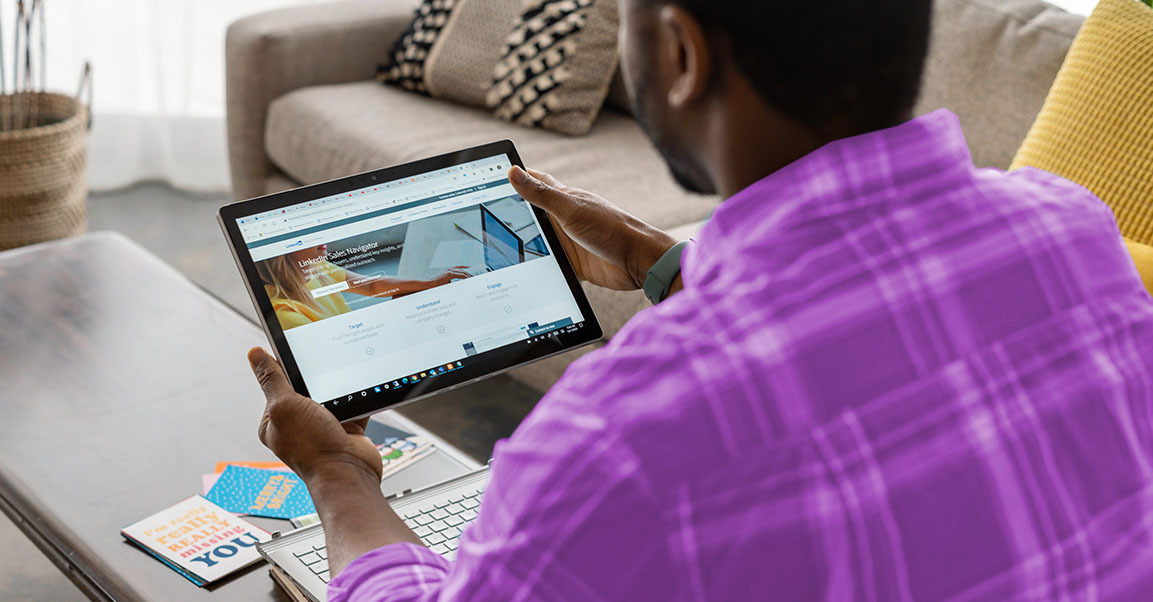If you or your team is in B2B sales, you know how powerful LinkedIn can be. With more than 900 million users and advanced search features that allow you to find your ideal customers in seconds, it’s a goldmine for B2B prospecting and selling.
Your sales reps have the ability to research companies, find the right contacts, learn about what motivates them, and connect on a person-to-person level that makes B2B sales as effective as possible.
Of course, it’s not just your team that has this advantage. Every sales department can easily access the same data and tools you have on LinkedIn.
That level of accessibility is both an advantage and a disadvantage for B2B sales. It’s easier to connect, but harder to stand out. Does it make sense to spend hours researching a specific prospect when your messages are just one of dozens that all look the same?
There’s still plenty of opportunity on LinkedIn, and your sales team can overcome these challenges. In this blog post, we’ll share our top 5 tips for closing more deals through LinkedIn.
1. Optimize your profile
Just as you can thoroughly research your prospects on LinkedIn, they can — and will — also research you. Make sure that your profile gives them plenty of good, valuable information to find.
Start with the first thing they’ll see: your profile picture. Use a smiling headshot that clearly shows your face.
Most of the time, your profile picture should be a close shot of your smiling face, professional attire (although not always), and a neutral background. Let your profile tell the rest of the story.
Next, take some time to polish your bio.
When a prospect clicks on your profile, they want to know who you are and what you do. Your bio should answer those questions quickly and clearly. Put yourself in a buyer’s shoes and consider what they want to know about you and your company before they consider doing business with you.
Of course, a good bio is just a short paragraph or two. Keep it brief and use links to allow your prospects to dig in as much or as little as they want.
Include links to your website, your portfolio, or to any public-facing pieces of content like case studies or whitepapers that you want your prospects to be able to see right away. Remember that B2B buyers, like most shoppers, want to do their own research before beginning the time-consuming process of talking to sales.
When your profile is ready for scrutiny, you’re ready for the next step.
2. Connect with potential customers
There’s a lot of information available on LinkedIn. How do you navigate it all?
The best way to use LinkedIn search is to leverage the available sorting functions to narrow down results and find exactly what you need. Do this through LinkedIn’s advanced search feature, which you’ll find by clicking the All Filters button on the right side of the search results page.

Filters allow you to search for people who work at a specific company or industry, who are actively posting about a topic you care about, and even those who are connected to someone you know.
As a LinkedIn Sales Navigator user, which we highly recommend using if you’re planning on making LinkedIn a regular part of your B2B sales strategy, you get even more advanced filtering options. You can search for prospect and company results by:
- Company type
- Company size
- Industry memberships
- Recent job changes
- Recent news mentions
- Seniority level
- Years in business
- Recent company leadership changes
- and more
Once you have your list of prospects, it’s time to start building those relationships.
While cold messaging is a valid strategy for some sales teams, you’ll stand out more and increase your close rates if you invest in building your rapport first. Start with a personalized connection request to your top prospects.
Bonus tip: Mixmax integrates with LinkedIn Sales Navigator to allow you to send connection requests and InMail directly from Gmail. It’s a huge time saver.
.png?width=600&height=600&name=Linkedin%20Sidebar%20(1).png) LinkedIn Sales Navigator sidebar in Gmail (via Mixmax)
LinkedIn Sales Navigator sidebar in Gmail (via Mixmax)
After you’re connected, engage with their posts and content on LinkedIn.
Don’t jump right to the sale. That’s a quick way to get relegated to the spam heap. Instead, join in the conversation by engaging with their posts and comments naturally.
Don’t monopolize the conversation or force yourself to make awkward comments, but do add your thoughts where it makes sense.
This process will be easier if you continually add new leads and prospects to your LinkedIn connections. That way, you won’t be tempted to hound top prospects because you’ll be busy with other tasks.
3. Join relevant LinkedIn groups
Search isn’t the only way to find people who fit your ICP. What if your ideal customer doesn’t have all of their personal information structured in their profile?
LinkedIn groups give you a chance to find and connect with more people who are (and who might be in the future) great prospects. You’ll build rapport naturally and learn more about the challenges and pain points you’re there to solve.
Find groups by using LinkedIn’s search filters to look for topics that make sense for your sales strategy. You might search for industry terms, or you can look for groups that are centered around the kinds of problems you solve or the software you make.
Once you join a group, remember that you’re there to participate and add value. It’s generally considered rude to make sales pitches in threads, especially as a new member.
Treat group membership as the chance to make new connections and build relationships, then send connection requests and proceed to your sales process only when you’ve made the appropriate level of connection with another group member.
4. Share valuable content
You’ve been connecting with prospects and joining in on their conversations. Now, let’s talk about how you can drive those discussions yourself.
LinkedIn is primarily a social media platform. That means that posting and sharing content is at the core of how the platform functions. You should get in the habit of posting and sharing things that are valuable and interesting to your audience regularly.
What’s valuable and interesting? That depends on who you want to connect with. Think about the kind of stuff that you read, and pay attention to what your connections share. That’s a great starting point.
Remember that the things you share help your connections get to know you over time. If you regularly share inflammatory or controversial articles, they’ll think of you in that light. Focus on content that fits your personal and professional brand.
What about posting about your product? Posting sales messages on your own feed is totally okay — in moderation.
At least 80% of the time, your posts should be hyper-focused on what your prospects care about. Then, you can make up to 20% of your content promotional posts that explain who you are, what you do, and how you can help.
5. Combine LinkedIn with other channels
The real power of LinkedIn is the ability to make personal connections. That doesn’t mean that you have to continue to do everything on one platform, though.
In fact, you’re much more likely to succeed if you use LinkedIn as just one piece of your multi-channel outreach strategy.
Here’s how a successful multi-channel approach might look:
- Day 1: You send a personalized connection request on LinkedIn.
- Day 3: You send an email to the prospect.
- Day 7: You notice that they’ve posted an article on their LinkedIn profile, and you comment on it with your thoughts.
- Day 10: You send a follow-up email.
- Day 14: Now that they know your name and a little bit about you, you make the sales call.
If that sounds like a lot of work, that’s okay. Remember that most salespeople try to jump directly to the sale and rely on large numbers of prospects with a low closing rate. By investing more in each relationship, you can increase your close rate and waste less effort.
You’ll also waste a lot less effort by using tools like Mixmax to automate a lot of the repetitive tasks involved with selling, like sending follow-up emails. That gives you more time to focus on higher-value relationship-building.
If you’re using Salesforce, you should also take advantage of Mixmax’s Salesforce integration or use a tool like Weflow to sync all your sales activities to your CRM. Removing the busy work from your sales process is key to making this high-touch LinkedIn strategy work.
Boosting your close rate on LinkedIn
LinkedIn is a powerful sales tool, but most sales teams fail to use it to its full potential. By focusing on the relationship-building capabilities of the platform instead of hoping for quick wins, you’ll see much better results than the average B2B salesperson on LinkedIn.
About the author
Catherine (Kitty) Solbrig is a well-rounded content marketer with more than 12 years of experience. Her work has been published by Automattic, GoDaddy, AOL, then American Bar Association, and many more high-tech companies.




